Amédée Gordini – a true racing legend
288 pages, 470 photos black and white and color, 8.25 x 10 inches
$89.95 plus shipping Order from Veloce Publishing, UK
Review by Pete Vack
Here at Last
The term ‘long-awaited’ is surely an understatement when applied to Roy Smith’s latest book. Not that it’s Roy’s fault, mind you, for without his effort there would probably be no book about Gordini at all, save Christian Huet’s remarkable and still handy Gordini Un Sorcier Une Equipe, published a generation ago in 1984. Fortunately the long wait was worth it; if you are the least bit interested in Grand Prix racing, Italian cars, French cars or just beautiful cars, Smith’s fantastic book should be part of your library.
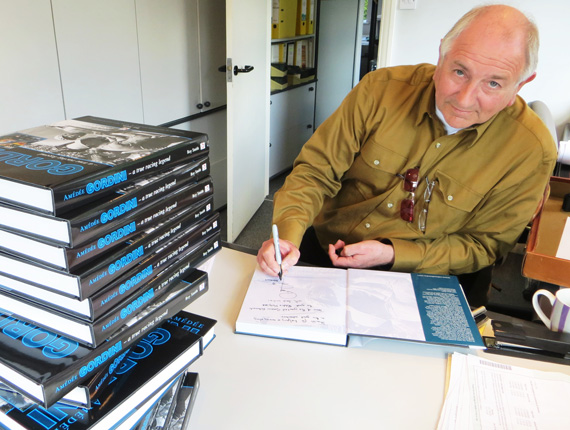
Roy Smith signing copies of his latest book. Bravo, Roy, from VeloceToday! Gordini owner Eddie McGuire took the photo.
The search for Amédée Gordini constitutes the last great quest for automotive historians, the last major Grand Prix team of the 1950s to be exhumed, exhausted, explained and exclaimed. Huet’s book, while superb, is long out of print and published only in French. Fortunately, Huet himself was fully behind Smith’s effort to conjure up a new book on the subject of the “Sorcerer”. As Huet wrote about the new book, “It is magnificent, so many not previously seen images, my old friend Amédée Gordini would have been very happy about this book of his life”.
But first don’t get us wrong. While relying a lot on Huet’s earlier work, Smith’s book is not just a translated update; it’s full of new information. And while Huet’s book stops at the retirement of the Gordini race cars in 1957, Smith goes the whole nine yards up to Gordini’s death in 1979 and covers the years with Renault and Alpine and the F1 engine that bore his name. In fact, Smith got interested in Gordini as a result of his previous three books on Renault and Alpine (all three are also superb books reviewed in VeloceToday).
Stunted interest
Smith’s work can and will stand on its own, having the benefit of another 30 years’ worth of accumulated knowledge. So, if you have the Huet book fear not Roy’s and buy it.
Gordini enthusiasts seem few and far between. It is possible that interest in Gordinis over the past fifty years has been stunted by the mere lack of the cars themselves. Roughly only 32 chassis were constructed and most were held by French Museums well into the 1990s. Few if any traded hands, none were actively vintage raced, or presented at major automotive shows and events. No cars, no interest, aside from devoted enthusiasts like Huet. But this may not be the only reason as even today, a 16 or 17 of the known Gordini chassis are still with the ex-Schlumpf collection, but a few, such as the Fangio/Gonzales coupe see the light of day once in a while.
But even Huet’s original book did little to spread the word, since apparently few would ever get the chance to actually own and drive one of Amédée’s jewels, the book too became almost a relic. Until – thank goodness – Smith got involved and brought Gordini back into the limelight, where of course it truly belongs. Smith’ book is solely in English, and at an extremely reasonable price of £55 or $89.95, it will do a lot to foster more worldwide attention on Gordini.
Smith told us that he really enjoys working with the staff at Veloce Publishing (no relation to VeloceToday). He told us, “I like the feel of it, it’s a proper book, a proper job and I like what they did with the images and the cover.” The book is a book…no coffee table work, little in the way of flashy layout, but a lot of text, explanations, with images that aid in the understanding of the topic. In somewhat of a twist, the book has all the Gordini race results and relevant chassis tables inserted not at the end as appendices, but placed between the team’s retirement and his years with Renault, serving to effectively break up the book as pre and post Renault.
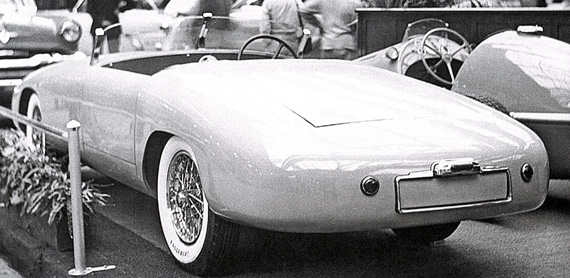
38S at Paris, 1952, in a stunning debut for a Gordini street car. They were never meant for road use, however; it was pure PR. Credit Gilles Blanchet
The tables are a wealth of information. We had just received a photo of a group of five Gordinis in the paddock of a race, with no year, identification, etc. But having the race numbers of the cars allowed us to scan through the table of competition appearances and therefore find the car numbers and the event in question. A further table lists each and every chassis number is listed with notes and corrections and another with design studies.
What’s inside
Smith has divided the Gordini epic into three parts; The Adventure Begins, 1899-1944; Following the Dream, 1945-1957; Legendary Status, 1958-Present Day. He gives a full account of Gordini’s later years but that only constitutes the last 26 pages of the book; his focus is clearly on the years of the Equipe.
He sheds some new light on Gordini’s earlier years in Paris, and his family life. The war years are not left blank for a change; Smith finds out all he can about what kinds of work Gordini did under the Todt Organization (the German engineering division responsible for a huge range of engineering projects in the occupied countries). Gordini did what he had to do to survive, but made sure that jobs that might aid the occupiers proceeded very slowly. Smith also notes that “…we have no real concept…of what it might be like to be occupied by an enemy…” But we can be sure it was a nasty time.
Smith also locates the Simca-Gordini-like Fiat-Gordini-Flahaults created from a couple of old Balillas sold by Gordini in 1947. Similar cars have recently shown up at shows and auctions so this will help identify those which have a real connection to Simca Gordini.
Much type is spent on race reporting, for this is what Gordini did, after all. From the start in the late 1930s to 1957, Gordini lived to race his cars, first as a driver then as team manager after the arrival of Jean Pierre Wimille and Raymond Sommer, whose driving talents were well beyond the norm. Wimille especially, was World Championship material, and his death in a Gordini at Buenos Aires in 1949 devastated the team. But the team grew to included Maurice Trintignant, Robert Manzon, Juan Fangio, Jean Behra as well as – on occasions – his own workshop managers! But in the maze of race reports, there are enough anecdotes and tails to keep the text flowing.
Gordini Brief
Amedee Gordini shared much with Bugatti, his neighbor Tony Lago, Enzo Ferrari and from his home region, the Maserati brothers. For years he ran a garage, virtually a front to cover for his only purpose in life; to build and race automobiles. While many of his best customers had to find other shops to complete work begun by Gordini, his race activities flourished with the help of Theodore Pigozzi at Simca. Limited by contract to race in certain events over 1100cc and under 1500cc (the Simca engine range), Gordini was frustrated to no end and wanted badly to run in Formula One events. Eventually, he got his way but at great cost. After a dismal failure of all four Gordinis at Le Mans in 1951, Simca withdrew their financial support of Gordini. Smith points out that it was not until the dawn of the Grand Prix of Rouen on July 8th that the announcement appeared in the papers, much to Gordini’s dismay. Unlike Ferrari and Maserati, Gordini sold no road cars and was almost entirely dependent upon the largess of Pigozzi at Simca. Gordini struggled on and had a few more great successes, but the last chapter of the Equipe dated from that July in 1951.
By late 1954 Gordini was fully engaged in producing the car of his dreams, an F1 car powered by a straight eight DOHC 2.5 liter engine. At the cusp of his career, finances were miserably tight. “Gordini, frustrated by the lack of interest from French companies, was feeling the strain.” He hurled insults at his chief designer, Pichetto; Behra had left for Maserati and his team no longer attracted talented drivers. Then Mercedes-Benz entered the field and made life totally miserable for everyone. The beautiful F1 car soldiered on through the end of the season with no luck.
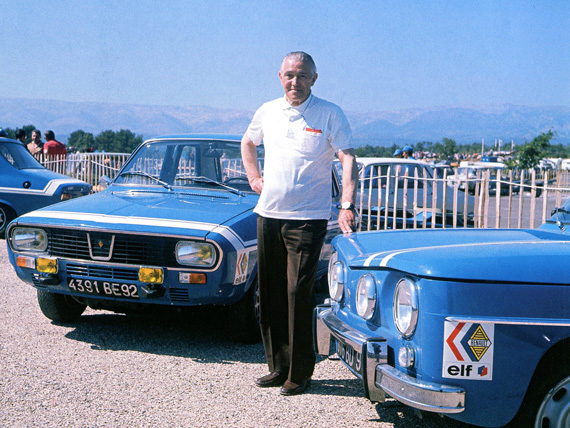
In 1970, Gordini stands with two of his projects that would make his name life on, the Renault 12 and Renault 8 Gordinis. Credit Phototèque Renault, France, copyrighted images, Renault Corporate Communications, all rights reserved.
At the 1956 Paris Motor Show, the Gordini stand touted “1946-1956—Over 250 Victories”. While true, few of those victories had come in the past several years. Gordini needed money and approached Pierre Dreyfus at Renault with some ideas about a Dauphine Gordini and a new era in Gordini’s life as a legend would begin.
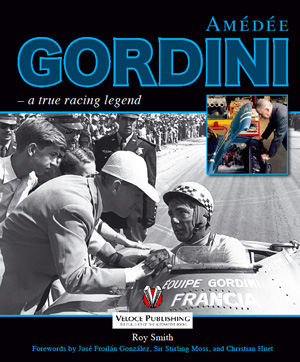 Roy’s book is superb, and try as we might, we have very few negatives to report. We didn’t like the light font of the captions; the index is complete but not as good as, say, Oosthoek’s Sports Car Racing in the South; we would have liked to see more historic color images; we liked the page by page display of each of the chassis with photos as compiled by Huet but Smith has updated this information with new chassis numbers and owners only in chart format. And that’s about it. It is simply one of those books that will become part of the Absolutely Essential Library.
Roy’s book is superb, and try as we might, we have very few negatives to report. We didn’t like the light font of the captions; the index is complete but not as good as, say, Oosthoek’s Sports Car Racing in the South; we would have liked to see more historic color images; we liked the page by page display of each of the chassis with photos as compiled by Huet but Smith has updated this information with new chassis numbers and owners only in chart format. And that’s about it. It is simply one of those books that will become part of the Absolutely Essential Library.
Other recent articles about Gordini:
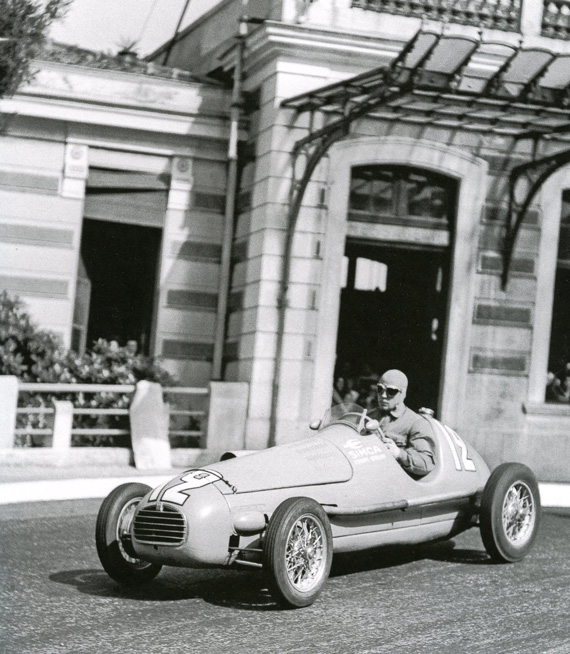
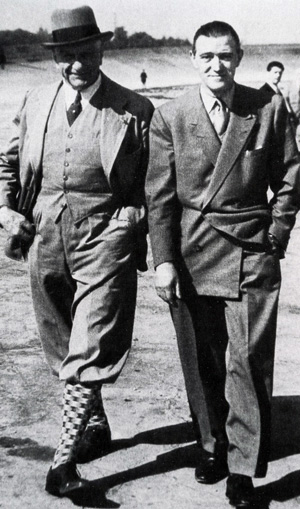
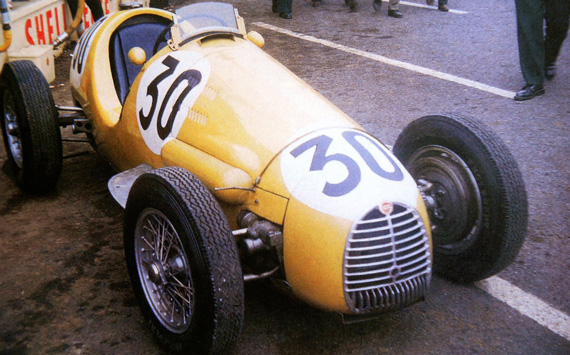
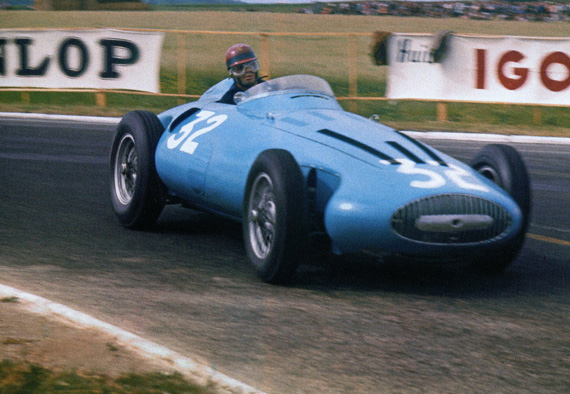

Dear Pete,
absolutely seconded!!
There are three other books worth mentionning:
Les Gordini by Robert Jarraud (edition L’automobiliste)
Gordini vecu par Robert Manzon (editions driver)
Amedeo Gordini by Claudio Balestri (slim biography)
Very best regards Michael
Correct and all are mentioned and credite where references are referred.
Sorry Roy,
I know!! I just meant the review only talked of C.Huet!!!
Thanks for the four books–can’t await the Alpine (Berlinette) tome!!
Best regards Michael
Soon to be in stock at Autobooks in Burbank, CA
The F1 results used here were initially compiled by Rob Ryder from a range of sources including Autocourse, Autosport and the F1 Register book mentioned above. The three additonal libre races were added by David McKinney. Individual car identities were then meticulously checked and corrected by Adam Ferrington using his own enormous library of books and photographs. David has also contributed extensively from his notes on car identities compiled over 40 years of research, Michael Müller has contributed immaculately researched histories of all the 1948-1950 Ferrari 125s, and Doug Nye, both through his books and his personal assitance on HWM, has also been of great help.
I have gotten stuck into Roy’s Gordini epic…very pleased that I helped push him to do it…few have made the contacts with the French racing community to do this sort of thing, or have the access to translators…so good job. I have copied the pages relevant to Angelo Molinari’s daughter who I know and will pass them onto her. Now how about Jean Behra, Johnny Servoz-Gavin etc??!!
Ed